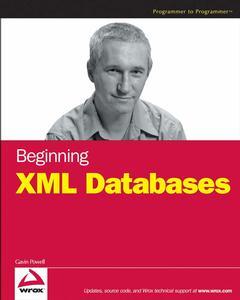Beginning XML Databases
Langue : Anglais
Auteur : POWELL Gavin

Supported by all major database systems, XML provides an easy, standardized method of transferring data between databases and to and from the Web, independent of the software in use. Offers database programmers and data-driven Web developers detailed guidance on how to understand and work with XML data. Numerous hands-on, step-by-step examples help readers learn to simplify database work using XML. Shows how to use XML to exchange data between multiple databases either internally or with external customers and partners. Covers scripting database servers with XML and popular languages (such as ASP. ET, PHP, and Perl) and using XML to work with data tables in Oracle, SQL Server, and DB2. Additional topics covered include native XML Databases, finding data with XML, and data modeling with XML DTDs.
Introduction. Chapter 1: What Is XML? Comparing HTML and XML. What Is XML Capable Of? What Is XSL? Creating and Displaying a Simple XML Document. Embedding XML in HTML Pages (Data Islands). Introducing the XML Document Object Model. XML Browsers and Different Internet Browsers. The Document Type Definition. XML Syntax. Elements. Attributes. Reserved Characters in XML. Ignoring the XML Parser with CDATA. What Are XML Namespaces? XML in Many Languages. Summary. Exercises. Chapter 2: The XML Document Object Model. Basic XML DOM Structure. The Primary XML DOM Classes. The Node Class. The Document Class. The Element Class. The Attr Class. The Text Class. More Obscure XML DOM Classes. The parseError Class. HTTPRequest Class. Other Classes. Generating XML Using ASP. Summary. Exercises. Chapter 3: Extending the Power of XML with XSL. What Is XSL? The Roots of XSL. Basic XSL Elements Syntax. Processing Instruction Elements. Transformation Elements. Node Creation Elements. Data Retrieval Elements. Control Structure Elements. Advanced XSL Syntax. Function Versus Method. XSL Function Syntax. XSL Method Syntax. XSL Pattern Matching Syntax. Combining the XML DOM and XSL. Summary. Exercises. Chapter 4: Relational Database Tables and XML. Using SQL for Database Access. Queries. Changing Data in a Database. Generating XML Pages Using Basic SQL. Summary. Exercises. Chapter 5: Oracle Database and XML. The Oracle XMLType Data Type. Oracle XMLType Data Type Methods. Implementing XML in an Oracle Database. Creating XML Documents from an Oracle Database. XML and the Database. New XML Documents. Retrieving from XML Documents. Using XMLType Methods to Read XML Documents. Changing and Removing XML Document Content. Summary. Exercises. Chapter 6: SQL Server and XML. The SQL Server XML Data Type. SQL Server XML Data Type Methods. Generating XML: The FOR XML Clause. FOR XML RAW Mode. FOR XML AUTO Mode. FOR XML EXPLICIT Mode. FOR XML PATH Mode. Generating Tuples from XML: OPENXML. Working with XML Data Types. Adding XML Documents to SQL Server. Retrieving and Modifying XML Data Types. Defining XML Content with XSD Schemas. Strongly Typing XML Documents with XSD. Mapping an XSD Schema to a Table. Annotating the XSD Script to Enforce Relationships. Storing XSD as a Schema Collection. Creating Indexes on XML Data Types. Summary. Exercises. Chapter 7: XML in Heterogeneous Environments. Basic XML Document Transfer. Sharing XML with Web Services. The HTTP Protocol. Transformation Processing. Web Services Protocol. Applying Semantics to XML Transfers. Simple Object Access Protocol. External Data and XML. B2B Data Transfer. Summary. Exercises. Chapter 8: Understanding XML Documents as Objects. Why Explain the Object Model Here? XML Data as a Relational Structure. The Basics of the Object Data Model. Creating an Object Model from a Relational Model. XML Data as an Object Structure. Summary. Exercises. Chapter 9: What Is a Native XML Database? An XML Document Is a Database. Defining a Native XML Database. Creating a Native XML Database. Schema-Less Native XML Database Collections. What Is Indexing? What About Using XSL and the XML DOM? Classify Native XML Databases by Content. Document-Centric XML. Data-Centric XML. Using a Native XML Database. Summary. Exercises. Chapter 10: Navigating XML Documents Using XPath. What Is XPath? Absolute and Relative Paths. XPath Nodes. XPath Node Relationships. XPath Expression Syntax. Simple Expressions to Find Nodes. Find Specific Values Using Predicates. Use Wildcards to Find Unknown Nodes. Expressions on Multiple Paths. XPath Axes. XPath Functions. Accessor Functions. Errors and Tracing. Constructor Functions. Numeric Functions. String Functions. URI Functions. Boolean Functions. Functions on Durations, Dates, and Times. QName Functions. Node Functions. Sequence Functions. Context Functions. Summary. Exercises. Chapter 11: Reading XML Documents Using XQuery. What Is XQuery? Shared Components. The Basics of XQuery. Executing XQuery Queries. Embedding XQuery Code into HTML. XQuery Terminology. XQuery Syntax. Functions in XQu
Date de parution : 11-2006
Ouvrage de 504 p.
Thèmes de Beginning XML Databases :
© 2024 LAVOISIER S.A.S.



